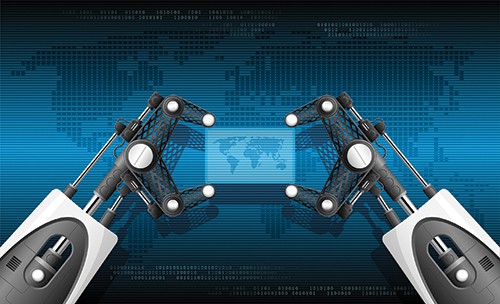Shipper-3PL Relationships Will Share Information Strategically
Part 3 of our 5-part series on Technologies Disrupting the Supply Chain
5 min read
 Murray Quibell
Feb 5, 2018 4:59:32 AM
Murray Quibell
Feb 5, 2018 4:59:32 AM

For years, 3D printing seemed like a far-off concept.
It’d be years before it had any impact on manufacturing beyond its potential use for prototypes.
Or it felt like a (sometimes silly) gimmick.
3D printer manufacturers would feature rock bands in their booths at large trade shows like CES playing instruments—guitars, drums, the whole nine yards—produced entirely with 3D printing.
But today, we’re seeing real-life examples of innovative companies using 3D printing in ways that are sure to be disruptive to supply chain management.
Late last year, Daimler Trucks North America announced a project to produce plastic replacement parts using 3D-printing technology.
Large commercial vehicles run for hundreds of thousands of miles, and the plastic pieces on the interior of the cab undergo years of wear and tear.
Replacing them is often difficult though, particularly for older trucks. If there is safety stock of the pieces at all—which is rarely the case—they are likely deep on a back shelf in a warehouse nowhere near where the truck is.
If there are no parts, they need to be produce, which requires ordering raw materials, changing out tools, and shipping the parts to where the truck is being serviced. If this is a “truck down” situation, that can mean a loss of revenue that can last weeks.
But on-demand printing of those parts means those trucks can be operational and on the road within a matter of days.
It also saves warehouse space. For now, Daimler is only producing a few, select parts this way. They will monitor performance to determine which parts to add in the future.
Perhaps not surprisingly, Amazon is looking to enter the 3D printing space as well.
Their need to stock millions of items in order to ship them in a matter of days—if not hours—requires they maintain huge warehouses at strategic locations around the country.
And that’s why they filed a patent for a mobile 3D printing apparatus. It would work something like this:
Again, this idea wouldn’t work for everything Amazon currently stocks in its warehouses, but for the several hundred items that could be 3D printed, a mobile printing unit could save the company millions of dollars in warehouse, transportation, and shipping costs.
With traditional manufacturing, materials are usually sourced and shipped from multiple suppliers to centralized facilities (usually factories) for processing and assembly.
The finished goods are then packaged, processed and shipped to distribution centers or waiting customers via a supply chain.
A study by Airbus showed that by redesigning its brackets for 3D printing, the company could achieve a 40% reduction in CO2 emissions over the lifecycle of the bracket and reduce the weight of the airplane by 10 kg.
In contrast, 3D printing can greatly reduce complexity in manufacturing and holds a number of additional advantages over conventional production techniques, including:
The operation of a 3d printer is quite similar to an inkjet printer, but instead of applying to paper, 3D printers inject materials in successive patterns to ‘build up’ a three-dimensional solid object.
Three basic ingredients are needed in order to 3D print an object:
Thus far, most industries have chosen to ignore the benefits of 3D printing. A notable exception to this trend is the medical industry, where the create of 3D-printed prosthetics and implants (hearing aids and dental crowns for e.g.) is now becoming increasingly common.
According to Ernst & Young’s Global 3D Printing Report 2016, 11% of companies are testing and experimenting with 3D printing, while just 3% claim significant experience with 3D printing and have a clear strategic plan at the highest management level for its future application.
Some reasons why adoption has been slow include lack of technological maturity for most industrial-grade applications, high costs for printers and materials, and limited knowledge about 3D printing technology.
Therefore, the widespread adoption of 3D printing will depend on the realization of five key success factors:
Encouraged by opportunities for greater customization, less waste, and more localized manufacturing and delivery, companies across many industries are showing more interest in 3D printing for manufacturing and as a source of new business models.
However, there remain many obstacles to achieving these objectives and today, at best, 3D printing remains a complementary process and not a substitutive one.
There is strong evidence that 3D printing will greatly impact manufacturing process in the future, but exactly when that happens, is anybody’s guess.
Article #1: Blockchain is Becoming a Crucial Link in the Supply Chain
Article #2: Automation and Digitization Will Shorten the Supply Chain
Article#3: Shipper-3PL Relationships Will Share Information at a Strategic Level
Article #4: Logistics is Experiencing a Talent Revolution
Article #5: 3D Printing will Add Strategic Flexibility to the Supply Chain – but When?

Part 3 of our 5-part series on Technologies Disrupting the Supply Chain

Part 2 of our 5-part series on Technologies Disrupting the Supply Chain What is Automation and Digitization? In their simplest forms, digitization...

Part 4 of our 5-part series on Technologies Disrupting the Supply Chain Since Aqurus Solutions is exhibiting at the Cargo Logistics Canada Expo and...